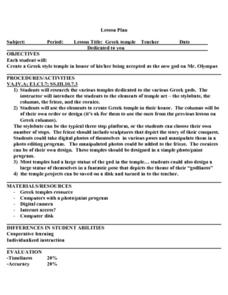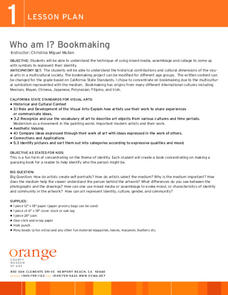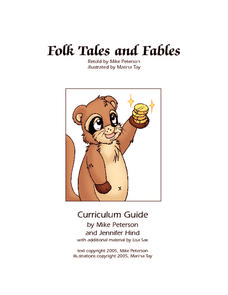Curated OER
Moving Pictures
Students review various pieces of artwork to determine the location and weather of the location portrayed. Using a Harris painting, they identify the sources of power and discuss solutions for using modern technology to solve any issues....
Curated OER
The Greek Temple
Learners engage in a lesson about the traditional Greek Temples and reflect upon how they are considered a work of art in modern times. They look at the architectural features that include the stylobate, columns, and the cornice. They...
Curated OER
Biology Chapter 15 Word Search Puzzle
In this biology worksheet, students look for the words that are related to the theme of the worksheet. They also work on the skills of spelling and word recognition.
Curated OER
Identifying Conflicts in Stories
Fifth graders practice analyzing story points by discussing Cinderella. For this reading comprehension lesson, 5th graders identify the four main types of conflicts in stories and how they are presented in modern day...
Curated OER
TE Activity: Tears in Rain
Students examine photographs before writing captions for them. They develop visual literacy as they see how photographs are manipulated to show the effects of acid rain. They rewrite the photo captions after a class discussion.
Curated OER
Who am I? Bookmaking
Students explore the process of bookmaking that has its origins from many different international cultures. The multicultural symbolism represented by the medium is utilized by students to expres their identity.
Curated OER
Coping With War: Diversions in a Century of Global Conflict
Eleventh graders analyze photographs representing leisure and transition during a global conflict. Working in groups, 11th graders review pictures from a web exhibit. The group completes a graphic organizer analyzing the photograph for...
Curated OER
Caesar
Young scholars examine patterns of imagery in Caesar by using online resources. Students compare the patterns they see to those they've found in other Shakespeare plays. Then young scholars draw conclusions about why Shakespeare might...
Curated OER
Hamlet
Students examine patterns of imagery in Hamlet by using online resources. Students compare the patterns they see to those they've found in other Shakespeare plays. Then students draw conclusions about why Shakespeare might have used the...
Curated OER
Richard II
Students examine patterns of imagery in Richard II by using online resources. Students compare the patterns they see to those they've found in other Shakespeare plays. Then students draw conclusions about why Shakespeare might have used...
Curated OER
Supporting the Classics!
Students identify the basic forms of classical architectural columns. Using the internet, they note the physical differences between Corinthian, Doric and Ionic columns. They design their own temple to their favorite Greek god or goddess...
Curated OER
The Olympic Rings
Students are introduced to the Olympic rings and their historic significance as an international symbol. Working in small groups, they research the history behind the Olympic symbol using traditional research methods. Using the intended...
Curated OER
Introduction to Modernist Poetry
Students analyze modernist poetry in depth and detail. The several historical, social, and cultural forces that prompted the modernist movement and its effects are examined in this activity.
Weekly Story Book
Folk Tales and Fables
Pages and pages of engaging activities, worksheets, and writing projects on teaching folktales and fables await you! You don't want to miss this incredible resource that not only includes a wide range of topics and graphic...
Curated OER
Exploring Arthurian Legend
Students investigate the evolution of the King Arthur stories and analyze them as a window into the culture that preserved them. They trace the legends through their earliest versions through medieval and Victorian times and into the...
Curated OER
Edgar Allen Poe: More Than the Master of Horror
Celebrate Poe's birthday with works that don't feature incorporeal hearts or evil houses.
Curated OER
Noteworthy?
Why do we have CliffsNotes? SparkNotes? Middle and high schoolers examine arguments for and against the recent influx of book notes, or study guides. They stage a debate in which they represent Advocates For or Critics Against the use of...
Curated OER
Shakespeare: Standing on the Bookshelves of Giant
A phenomenal lesson on Shakespeare! Middle and high school learners create WebQuests about the texts and authors that Shakespeare himself studied when he was in grammar school. They use a variety of media in order to create dramatic...
Curated OER
Egyptian Cartouche
Sixth graders demonstrate their knowledge of Earth clay construction by creating, inscribing, and glazing an earth clay Egyptian cartouche. The instructional activity culminates with learners sharing their knowledge of key terms in the...
Curated OER
Who's Got Game? The Lion or the Mouse?
Discuss bullying, folk tales, and more using this resource. Learners read the story The Lion and the Mouse by Toni and Slade Morrison, engage in cause and effect activities, make predictions, and discuss bullying. This is a motivating...
Japan Society
Popular Culture and Japan’s Gross National Cool
From Manga to Godzilla and Pokemon, Japanese pop culture has been taking the globe by storm. This phenomenon is called "soft power." Learners will examine the differences between hard and soft power, as well as learn the historical...
Shakespeare Uncovered
Women’s Roles in As You Like It
“There is nothing that becommeth a maid better than soberness, silence, shamefastness, and chastity, both of body & mind.” This line, from Thomas Bentley ‘s The Monument of Matrons published in 1582, typifies the way women were...
C.S. Lewis Foundation
Study Guide to Letters to Malcolm
C.S. Lewis outlines in his final book Letters to Malcolm: Chiefly on Prayer, the struggle of what happens during prayer, and the purpose of the action. The resource provides two sets of questioning. The first furnishes deep...
Utah Education Network (UEN)
8th Grade Poetry: A to Z Poem
A two-part lesson asks eighth graders first to draw connections between the myth of Aengus and William Butler Yeats' poem "The Song of Wandering Aengus." In the second part of the lesson, writers craft an "A to Z Poem."























